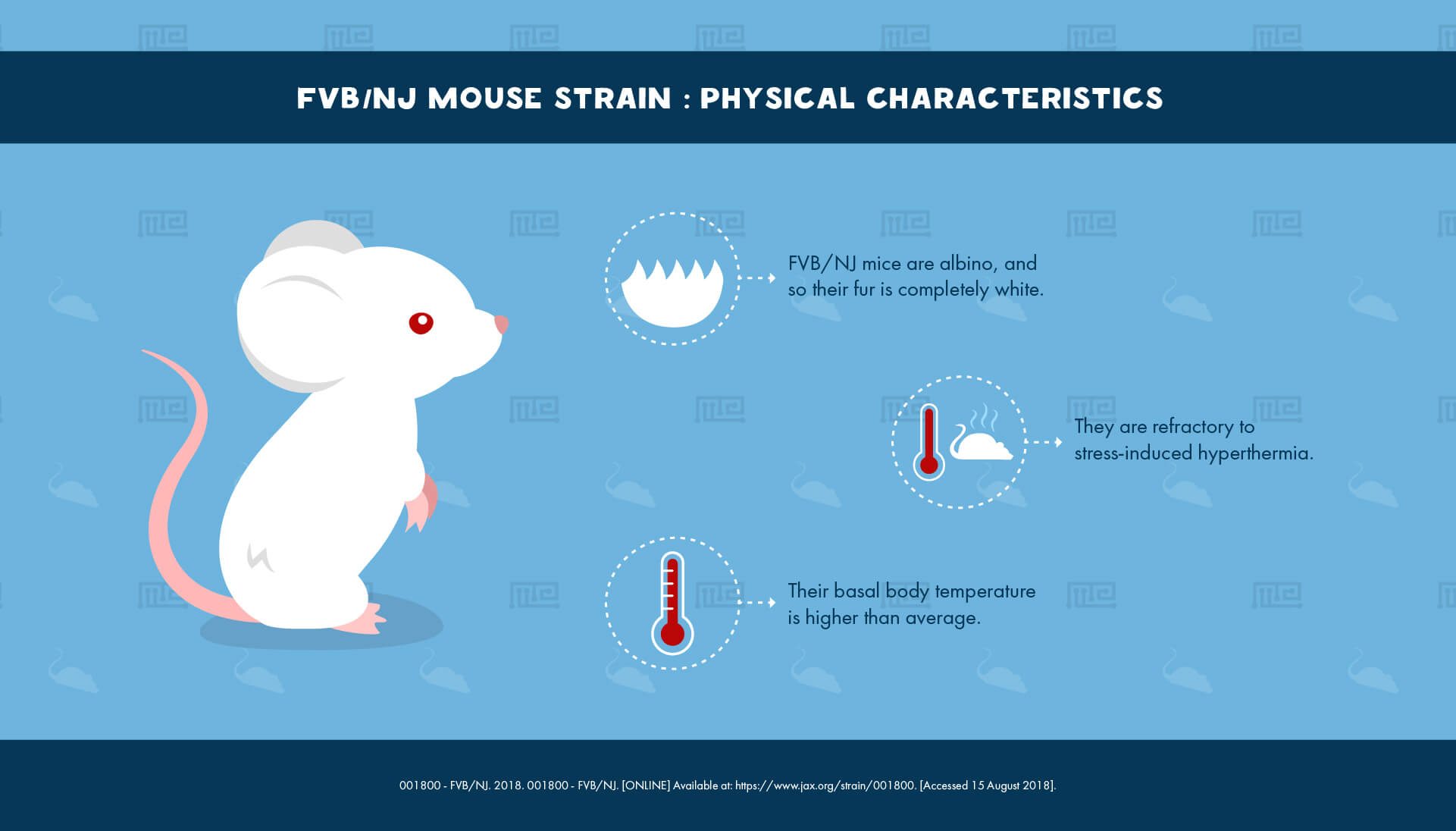Overview
FVB/NJ is an inbred strain of mouse model that is most commonly used for transgenic applications.
History
The FVB/NJ strain derives from Swiss mice that first came to the National Institutes of Health in 1935. These outbred mice then underwent selective breeding in the late 1960s for both low and high sensitivity to histamine.[1][2]
The histamine sensitive strain, then known as HSFS/N, spontaneously acquired an allele conferring sensitivity to a leukemia virus. These mice were selectively bred for this leukemia sensitivity to produce the strain FVB/N. Finally, Taketo took these mice into the Jackson Laboratory in 1988, where the FVB/NJ strain was developed.[1][2]
Physical Characteristics
FVB/NJ mice are albino, and so their fur is completely white. Their basal body temperature is higher than average, and they are refractory to stress-induced hyperthermia.[1]
Behavioral Characteristics & Handling
While it is not as handling-friendly as the most commonly used inbred strains such as C57BL/6J and BALB/cByJ, reports suggest that researchers can be reasonably confident in dealing safely with individuals of the FVB/NJ strain.
A Canadian study comparing the ease of handling of 21 different commonly used mouse strains reports that FVB/NJ mice showed an intermediate level of placidity. This strain exhibited a small degree of evasive behavior when captured, as well as struggling and squeaking with intermediate frequency when held.[3]
One study reports higher frequency and duration of aggressive behavior by the ancestral FVB/N strain in the resident-intruder test.[4] There is no published data confirming whether or not this heightened aggression has been passed on and retained with FVB/NJ, but anecdotal evidence on academic forums suggest it has.
FVB/NJ mice show more than average spontaneous activity, as well as higher than average anxiety.[1] They perform badly on the Morris water maze test of spatial learning and memory, which may be a function of their visual deficits.[4]
Health Characteristics
As detailed above, FVB/NJ is descended from a lineage that was deliberately selected for the mutant Fvb1 allele (hence the strain name) which confers much greater than normal susceptibility to the leukemia-causing virus Friend leukemia virus B. These mice are also unusually susceptible to squamous cell carcinoma, with frequent conversion from papilloma to carcinoma.[1]
Despite their high incidence of cancer and tumor development (the latter at 55% in males and 66% in females), the mice of this strain have a reasonably normal lifespan under lab conditions, with 60% living beyond two years.[2]
FVB/NJ mice show substantial production of the antibody IgE following an irritant stimulus of their lungs, a phenotype which mirrors asthma in humans. These asthma-like responses are much more similar to human asthma than are the responses of other mouse strains.[1]
They do not develop collagen-induced arthritis, despite possessing an MHC haplotype which normally confers the condition. This is because they also have polymorphisms in the gene for T cell receptor B which counteract the MHC aberrations.[1]
Like a number of commonly used inbred mouse strains, FVB/NJ mice are homozygous for the mutant phosphodiesterase 6b allele Pde6brd1 which confers retinal degeneration, beginning at weaning age and eventually leading to complete blindness.[1]
Major Experimental Uses
FVB/NJ mice have long been preferentially used for the generation of transgenic stocks, on account of several useful phenotypic quirks they possess. They breed well with large litters, their zygotes have large and easily visible pronuclei which makes DNA injection a lot easier, and they survive as hybrids much better than other strains such as C57BL/6J.[1][2]
In addition to transgenics, mice of this strain have been used in research on salmonella, cancer, asthma, and retinal degeneration.[1]
References
- 001800 – FVB/NJ. 2018. 001800 – FVB/NJ. [ONLINE] Available at: https://www.jax.org/strain/001800. [Accessed 15 August 2018].
- MGI – Inbred Strains: FVB. 2018. MGI – Inbred Strains: FVB. [ONLINE] Available at: http://www.informatics.jax.org/inbred_strains/mouse/docs/FVB.shtml. [Accessed 15 August 2018].
- Wahlsten, D. Metten, P. Crabbe, JC. 2003. A rating scale for the wildness and ease of handling laboratory mice: results for 21 inbred strains tested in two laboratories. Genes, Brain and Behavior. 2; 71-79.
- Perdita L. PughSharlin F. Ahmed Martin I. Smith Neil Upton A.Jacqueline Hunter. A behavioural characterisation of the FVB/N mouse strain. Behavioural Brain Research
- Volume 155, Issue 2, 6 December 2004, Pages 283-289.


